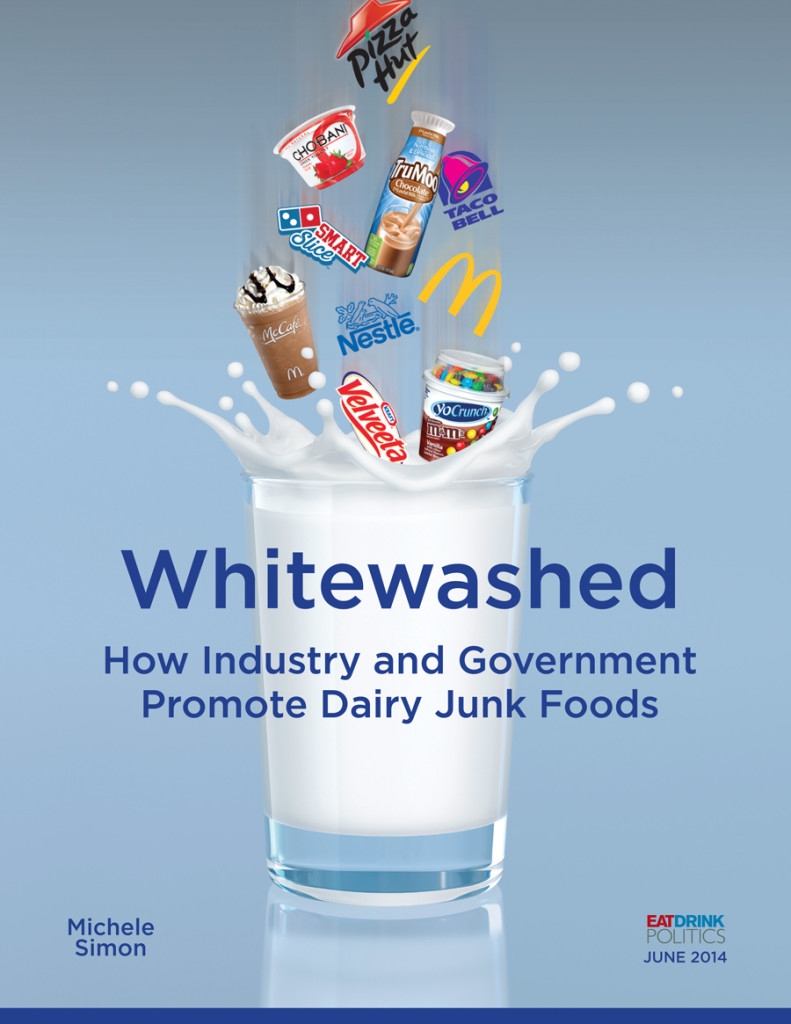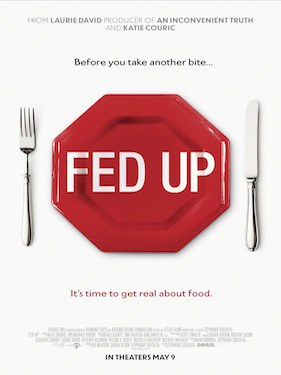
Big Food
Posted on Tuesday, November 4th, 2014 by Michele Simon
Voter initiatives in California, Oregon and Colorado illustrate what’s at stake in the food wars
On Nov. 4, voters in three Western states will decide four food-related ballot measures that seem to have little in common: The two state-level measures (in Oregon and Colorado) would require genetically engineered (aka GMO) foods to be labeled as such, and two local initiatives in California (in San Francisco and Berkeley) would place a small tax on sugary soft drinks. But they do have something in common. A large portion of the opposition for all four measures is being funded by two megacorporations: Coca-Cola and PepsiCo. Moreover, the opposition is using many of the same tactics. Read rest at Al Jazeera America …
Posted in Big Food, Food Policy, Industry Tactics | Tagged: Big Soda, GMO labeling, GMOs, soda taxes | Michele on Google+ | View/Add Comments (0) |
Posted on Tuesday, October 28th, 2014 by Michele Simon
The natural products business is booming. By some industry estimates, retail sales topped an eye-popping $100 billion last year, with nearly 60 percent coming from food. No wonder more food marketers are labeling their products — from Pepsi to Cheetos — natural. But what does the term actually mean?
Despite the term’s popularity — or because of it — there is no official definition of “natural.” With the potential to deceive consumers, the issue is now reaching a breaking point. The proposed solutions from trade groups, lawyers and government agencies range from defining the term to suing over it to ignoring it. Some consumer-advocacy organizations are even calling for a complete ban on the use of “natural” in labeling. But such disparate approaches won’t help shoppers become any less confused and may even make the problem worse.
Read rest at Al Jazeera America ….
Posted in Big Food, Food Policy, Industry Tactics | Tagged: advertising regulation, FDA, GMO labeling, GMOs, junk food, trade groups, voluntary self-regulation | Michele on Google+ | View/Add Comments (0) |
Posted on Monday, August 18th, 2014 by Michele Simon
As I wrote in June, a bitter fight erupted in Washington, D.C., when the School Nutrition Association (SNA) — representing the nation’s 55,000 school food professionals — decided to oppose nutrition improvements to federally subsidized school meals, claiming that districts face insurmountable challenges from too many changes happening too quickly. Michelle Obama has made the Healthy Hunger-Free Kids Act of 2010 one of her top causes and she is pulling no punches defending the new rules, which require schools to serve lower-sodium and lower-fat meals with more whole grains and fruit and vegetable servings. The result is an unfortunate standoff between the White House and the SNA’s current leadership. Read rest at Al Jazeera America ....
Posted in Big Food, Child Nutrition, Industry Tactics, Marketing to Children | | Michele on Google+ | View/Add Comments (0) |
Posted on Wednesday, July 30th, 2014 by Michele Simon
 I recently attended the annual meeting of the School Nutrition Association, the trade group that represents the 55,000 food service workers who have the thankless job of feeding millions of schoolchildren every day. While there, I tweeted out a few photos I took on the expo floor and I’ve uploaded all 82 of them to Instagram here.
I recently attended the annual meeting of the School Nutrition Association, the trade group that represents the 55,000 food service workers who have the thankless job of feeding millions of schoolchildren every day. While there, I tweeted out a few photos I took on the expo floor and I’ve uploaded all 82 of them to Instagram here.
The images are more or less organized by either food category or company. Several of the event’s official sponsors, including Tyson, PepsiCo, and Domino’s were listed on prominent signs here and here.
First is a series of mascots, including Smuckers, Chester the Cheetah, and the State Fair hotdog. At the National Dairy Council booth, attendees were lined up to have their photo taken with a statue of a cow. Why? Because (I was told) they would get a plush toy cow. The booth was promoting “Fuel up to Play” a nutrition program in schools that emphasizes dairy.
Continue reading →
Posted in Big Food, Child Nutrition, Industry Tactics, Marketing to Children | | Michele on Google+ | View/Add Comments (1) |
Posted on Wednesday, June 25th, 2014 by Michele Simon
School Nutrition Association includes such Big Food sponsors as PepsiCo, Domino’s and Muffin Town.
Perhaps the most visible advocate for improving school food, Michelle Obama is now defending what shouldn’t be such a controversial idea: adding fruits and vegetables to public school lunches. Ask any nutrition expert what foods Americans — especially kids — need more of in their diet, and the answer would be the same: fresh produce. But some Republicans, such as Rep. Robert Aderholt of Alabama, never seem to miss an opportunity to turn a no-brainer into a political battle, particularly when it comes to school food. (Who can forget the pizza as a vegetable debacle?) And just in time to give them the necessary cover, they got a gift from an unlikely source. The School Nutrition Association (SNA) has asked Congress to approve waiver requests for schools that are struggling to comply with federal nutrition regulations aimed at improving children’s health.
Read rest at Al Jazeera America …
Posted in Big Food, Child Nutrition, Industry Tactics, Marketing to Children | Tagged: Academy of Nutrition and Dietetics, child nutrition, childhood obesity, junk food, Let's Move, lobbying, Obama, school food policy, USDA | Michele on Google+ | View/Add Comments (0) |
Posted on Wednesday, June 11th, 2014 by Michele Simon
 The United States is in the midst of a public health epidemic due to poor diet. While much of the focus has been on obvious culprits such as sugary soft drinks and fast food, dairy foods often get a pass. The dairy industry, propped up by government, has convinced us of the health benefits of milk and other dairy products. But the context of how people consume dairy matters.
The United States is in the midst of a public health epidemic due to poor diet. While much of the focus has been on obvious culprits such as sugary soft drinks and fast food, dairy foods often get a pass. The dairy industry, propped up by government, has convinced us of the health benefits of milk and other dairy products. But the context of how people consume dairy matters.
Continue reading →
Posted in Big Food, Child Nutrition, Food Policy, Industry Tactics, Marketing to Children, Public Health | Tagged: child nutrition, childhood obesity, dairy, deceptive health claims, junk food, school food policy, USDA | Michele on Google+ | View/Add Comments (79) |
Posted on Sunday, May 11th, 2014 by Michele Simon
Am thrilled to be featured in a new powerful film by Laurie David and Katie Couric that features an all-star line-up.

If you search for “Fed Up movie” on Google, the first link you see is not the film’s website, but rather a page from the Grocery Manufacturers Association called “Fed Up Facts“. It’s a silly and desperate attempt by Big Food to respond to the star-power that has Katie Couric appearing all over the mainstream media spreading a message that the food industry doesn’t want you to hear. (GMA denies that “the food industry purposely advertises unhealthy foods to children”. It must happen by accident.)
The film really pulls no punches aiming to dispel the junk food industry’s strongest talking points: it’s all a matter of personal responsibility; we can just exercise our way to health; and we don’t need government regulation. Even Let’s Move is criticized for placing too much emphasis on physical activity and industry partnerships. But as I told the filmmakers, the first lady is in the wrong wing of the White House. (That quote didn’t make the final cut, alas. See this review saying the film lacks policy solutions, which I mostly agree with.)
Continue reading →
Posted in Big Food, Child Nutrition, Industry Tactics, Marketing to Children, Media, Public Health | Tagged: Big Food, childhood obesity, Grocery Manufacturers Association, junk food | Michele on Google+ | View/Add Comments (5) |









 I recently attended the annual meeting of the School Nutrition Association, the trade group that represents the 55,000 food service workers who have the thankless job of feeding millions of schoolchildren every day. While there, I tweeted out a few photos I took on the expo floor and I’ve uploaded all 82 of them to Instagram
I recently attended the annual meeting of the School Nutrition Association, the trade group that represents the 55,000 food service workers who have the thankless job of feeding millions of schoolchildren every day. While there, I tweeted out a few photos I took on the expo floor and I’ve uploaded all 82 of them to Instagram 





